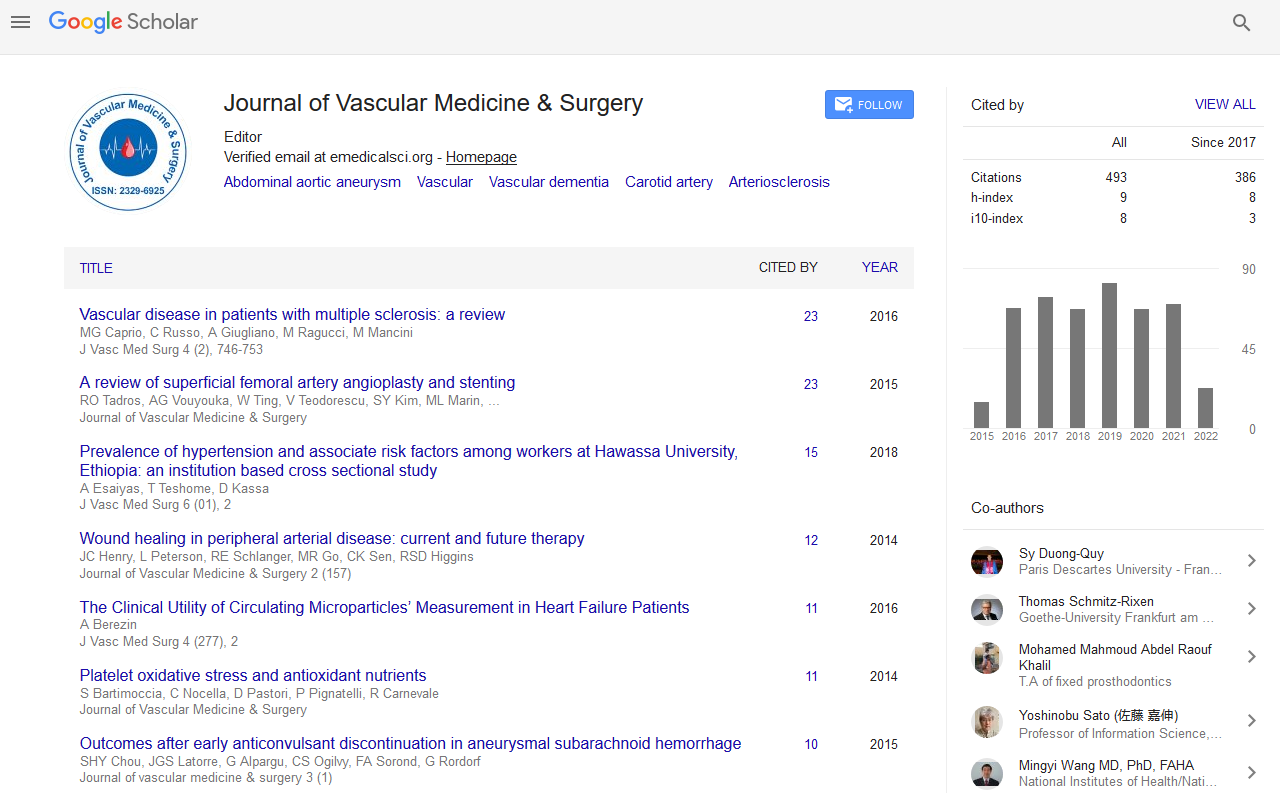Indexed In
- Open J Gate
- Academic Keys
- RefSeek
- Hamdard University
- EBSCO A-Z
- OCLC- WorldCat
- Publons
- Euro Pub
- Google Scholar
Useful Links
Share This Page
Journal Flyer

Open Access Journals
- Agri and Aquaculture
- Biochemistry
- Bioinformatics & Systems Biology
- Business & Management
- Chemistry
- Clinical Sciences
- Engineering
- Food & Nutrition
- General Science
- Genetics & Molecular Biology
- Immunology & Microbiology
- Medical Sciences
- Neuroscience & Psychology
- Nursing & Health Care
- Pharmaceutical Sciences
Abstract
The Scope of Cardiac Surgery at a National Cardiothoracic Center of Excellence (NCTCE) in Nigeria: A 3-Year Review
Nwafor IA, Eze JC, Anyanwu CH, Ezemba N, Onyia UOC, Enwerem NU, Nwafor MN, Chinawa JM and Anisuba B
Background: The heart with its intrinsic and indispensable function is a vital organ in the human body. Surgical management of diseases affecting it was initially thought to be incompatible with life. Surgeons who desired the respect of their colleagues were barred from operating on the heart, on the ground that human knowledge is very limited in that area. This notion was however changed in 1893 when laceration in the left ventricle was successfully repaired at Chicago Provident Hospital in USA. Three years later, the same feat was successfully reproduced several times in Frankfurt Germany. Also by 1938 in Boston Children Hospital, Massachusetts, USA, Robert Gross successfully interrupted a PDA in a 7-yearold child. This was followed by successful repair of coarctation of the aorta and the famous blue baby operation, all in 1944, thus unequivocally, proving that successful operation on the heart was tenable in the western world. On the contrary, in the early 1940s and 1950s, cardiac diseases requiring surgery for whole or part of their management were thought to be rare in Nigeria in particular and Africa in general. The establishment of cardiac registry at UCH, Ibadan in western Nigeria, in 1964 revealed all types of cardiac diseases including those requiring surgical intervention. Today, many cardiac diseases are treated by surgery in NCTCE, UNTH, Enugu and other centers in Nigeria. The western world is abandoning the perfected conventional open access cardiac surgery for minimal invasive cardiac surgery with comparable results vis-à-vis efficacy. Aim/Objective: To determine the scope of cardiac surgery at the National Cardiothoracic Center of Excellence and compare same with the continental and international standard. Materials and method: This is a retrospective study. From March, 2013 to February, 2016, (3 years) all case records of those that underwent cardiac operations at NCTCE were retrieved and analyzed using simple arithmetic method. Those who were diagnosed but could not be operated on, who either died or referred abroad due to the complexity of their cardiac diseases were excluded from the study. Results: During this period, spanning 3 years, a total of 209 cardiac operations were carried out, about 69.7 cases per year. The age range of the patients that were operated was 1 year to 72 years with a mean of 2.9. Of this number, 128 (61.2%) were males and 81 (38.8%) were females with a ratio of 1.6: 1. Also, open heart procedures constituted about 125 (59.6%), while closed heart procedures were 84 (40.4%). Out of 125 cases of open heart procedures, 79 (63.1%) were for acquired adult heart diseases while 46 (36.9%) were for congenital heart diseases. Mean hospitalization at the intensive care unit was 72 hours while the mean hospital stay was ten days. Mortality was about 25 (12.0%). Conclusion: From the results, NCTCE carried out significant number of cases during the period when compared to previous years. However, the youngest age group was 1 year old, suggesting that those below that age group were referred out. The mean hospital stay is relatively longer, suggesting that complications might have contributed.


